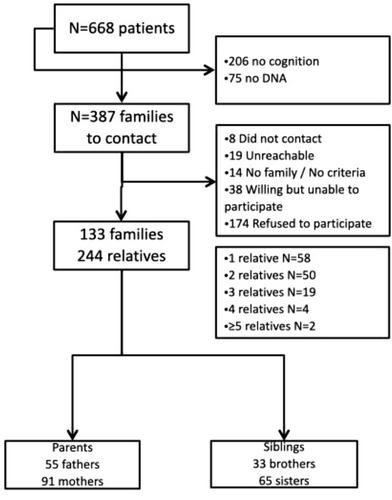Motor Dexterity Deficits in Individuals With First-Episode Psychosis and Their First-Degree Relatives
Abstract
Introduction
Motor dexterity deficits have been observed both before and during first-episode psychosis (FEP), suggesting this may be a potential endophenotype for schizophrenia spectrum disorders. We aimed to compare motor dexterity performance in FEP patients, their first-degree relatives, and controls. We also investigated whether sociodemographic, premorbid, clinical, and cognitive factors contribute to motor dexterity.
Methods
The sample included 133 FEP patients, 244 of their first-degree relatives (146 parents, 98 siblings), and 202 controls. Motor dexterity was assessed using the Grooved Pegboard Test as part of a neuropsychological battery assessing verbal and visual memory, processing speed, working memory, executive function, attention, and theory of mind. Raw scores were converted to Z-scores. Intelligence quotient and global cognitive function were estimated. Group comparisons were made using analysis of covariance with post hoc tests. Age, sex, and years of education were included as covariates. Multiple linear regression models examined associations between motor dexterity and other variables within each group.
Results
There was a significant group difference on the Grooved Pegboard Test (F = 16.25, p < 0.001). FEP patients (M = −1.26) and their parents (M = −1.14) scored lowest, while siblings (M = −0.30) and controls (M = −0.22) scored highest. The FEP group also scored lowest on other cognitive tests (p < 0.001). A positive association between global cognitive function and Grooved Pegboard performance was found in all groups (β = 0.47–0.84, p < 0.001). Group-specific associations with age, sex, education, intelligence, executive function, attention, and processing speed were also observed (p < 0.05).
Conclusions
Motor dexterity deficits were observed in FEP patients and their parents, which may reflect underlying genetic liability or result from the disorder itself. The preserved motor dexterity in unaffected siblings challenges a strict endophenotypic interpretation and suggests a potential protective effect. Motor dexterity deficits were associated with broader cognitive impairment, intelligence quotient, attention, processing speed, and executive function.


 求助内容:
求助内容: 应助结果提醒方式:
应助结果提醒方式:


